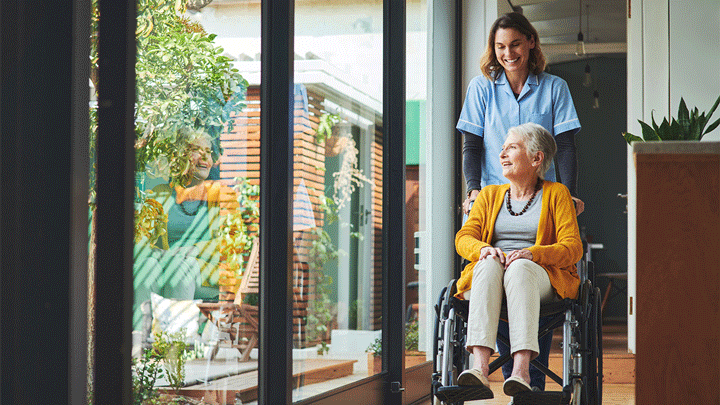Better Indoor Air Solutions Can Improve the Health of Your Residents
Humans spend roughly 90% of their day indoors on average and Long Term Care (LTC) residents often spend as much or more time inside than the average person. Because of this, indoor air quality (IAQ) can greatly influence the health and wellness of Senior Living residents1. If your facility uses an appropriate indoor air quality solution, you may see improvements not just in resident health and wellness, but also in your staff, finances, and operations.
A recent study shows that reduction of fine particulate matter (microscopic particles of liquid or solid matter suspended in the air) in older women’s living environments reduced dementia risk by 14% to 26%2. In addition, this same reduction produced slower cognitive decline in older women.
Administrators looking for ways to reduce the risk of illness and increase resident well being should pay attention to the quality of their facility’s indoor air. Once areas of improvement are identified, the right indoor air solutions can be selected.
Webinar available now: Indoor Air Quality in Long Term Care: Vital for Infection Control, Operational Efficiency, and Clinical Outcomes
Learn more about the impact of indoor air quality on your residents, staff, and business outcomes from our expert panel. You’ll walk away with actionable ideas you can implement in your facility to help create a better indoor environment for your community.
Indoor Air Quality: An Invisible Contributor to Resident Health
It is not always easy to identify poor IAQ. As shown in this recent survey of Senior Living administrators, 78% of admins believe their indoor air quality to be good or excellent. However, studies show that 81% of Long Term Care facilities suffer from inadequate air ventilation and circulation3. This is a serious issue, considering that indoor air is often 2 to 5 times more polluted than outdoor air4.
Read on to explore the health implications of poor IAQ for residents and indoor air solutions to help you improve the quality of your facility’s air for better resident health outcomes.
What is Indoor Air Quality?
Indoor air quality refers to the quality of the air in any indoor environment. Typical measurements include size/quantity of particulate matter (PM) and presence of volatile organic compounds (VOC).
Air quality indoors can range from excellent to poor. The difference between excellent and poor IAQ can be drastic and noticeable. However, even “adequate” IAQ may not optimize the health of your residents, as indoor standards of air quality are not as highly regulated as outdoor or ambient air5. Instead, administrators should consider solutions that help create excellent air quality in their facility.
What Contributes to Poor IAQ in Long Term Care Facilities?
A wide variety of factors can impact the quality of your facility’s air. Common pollutants include:
- Airborne infectious disease particles
- Volatile organic compounds, which can be found in cleaning products, paint, flooring, upholstery, foam, carpets, caulk, adhesives, soaps, hairspray, nail polish, etc.
- Poor ventilation causing air to stagnate and become more polluted over time
- Odors
- Particulate matter as a byproduct of combustion (a common source of this is cooking)
- Carbon dioxide from exhalation
- Off-gassing from a number of different sources ranging from personal use items to building materials
- The introduction of unclean outdoor or ambient air to an indoor environment
- Mold
- Airborne infectious disease particles
- Pet dander
- Pesticides, lead, and asbestos
- Ozone, which is created by chemical reactions of multiple pollutants in the air
How Does IAQ Impact Your Residents?
Indoor air pollution is nearly always invisible. This can be true even in highly polluted indoor environments and even in cities or towns where there is visible outdoor air pollution such as smoke or smog. Because of this, it can be easy to believe that your facility’s indoor air isn’t polluted, and therefore could not contribute to acute and chronic illness in your residents.
In reality, the health impacts of your facility’s air on residents can be quite serious. We breathe 2,000 gallons of air every day. If each breath introduces any number of the pollutants listed above into the lungs of your residents, the health outcomes will likely be worse than if they breathed clean air every day.
Let’s take a look at some common health risks associated with poor IAQ.
Negative Health Effects of Poor IAQ
The World Health Organization (WHO) states that 7 million deaths each year are caused by exposure to air pollution6. Moreover, the WHO attributes causation of certain noncommunicable diseases such as stroke, heart disease, chronic obstructive pulmonary disease (COPD)7, and lung cancer specifically to indoor air pollution8.
A recent study also shows that older women residing in high pollution environments are nearly twice as likely to develop dementia9. It has also long been understood that poor air quality both indoors and outdoors worsens symptoms of asthma in individuals of all ages10.
Airborne infectious diseases are also a greater risk when indoor air quality is poor. As the COVID-19 pandemic showed, it is essential to provide clean air to Senior Living residents to reduce the risk of spreading SARS-CoV-2 and other airborne communicable diseases such as Pertussis, Respiratory Syncytial Virus (RSV), and Influenza.
Not every resident will experience these more severe health outcomes, but they may live with minor physical symptoms of poor air quality such as post-nasal drip, rhinitis, cough, wheeze, itchy eyes, and more11. While indoor air quality is not the only factor that can contribute to these health issues, it can play a significant role in the development or worsening of these and other illnesses.
Positive Health Outcomes Resulting From IAQ Improvement
The Environmental Protection Agency plainly states that improved air quality reduces premature death and many serious health issues12 including some of those listed above. This is true for people of all ages, and even more true for vulnerable populations prone to health complications such as the Senior Living residents in your facility.
How Can You Improve Indoor Air Quality in Your LTC Facility?
Residents, prospective residents, and their caregivers are more concerned about indoor air quality than ever before.
A recent Delos survey found that 63% of prospective residents and their caregivers would choose one facility over another based on the facility’s proven commitment to bettering their indoor air quality13.
Administrators who hope to both improve health outcomes for their residents and increase census should consider the following indoor air solutions as an important investment in their facility.
Indoor Air Solutions for Long Term Care Facilities
Ventilation
Ventilation dilutes particulate matter in the air of your facility by introducing new outside air. You can create natural ventilation by opening windows and doors in your facility at regular intervals and portable fans can help circulate the air out of the space.
In instances when opening doors and/or windows is not possible, installing and using exhaust fans can also help to ventilate your facility.
Filtration
Your HVAC system can help you remove particulate matter from your facility’s environment through the use of proper filters. MERV-13 filters or higher are recommended for use if your system is designed to handle this type of filter. In addition, portable air filters are a simple way to help clean the air from room to room in your facility.
Claim up to $3,000 in CMP funding for IAQ devices
Right now, Centers for Medicare & Medicaid Services (CMS) offers funding through the Civil Monetary Penalties Reimbursement Program (CMPRP) for qualified nursing homes to receive up to $3,000 specifically for portable air filtration devices using HEPA filters and portable fans.
This is an excellent time to secure better portable indoor air solutions for your facility. Funding is available on a first-come, first-served basis, so act fast if you want to upgrade your facility’s portable filtration devices. Facilities must apply through their State’s CMP office.
Contact a Direct Supply account manager for up-to-date information about state-specific funding availability.
Purification
Air purification devices clean the air itself, rather than circulate it or remove it. Devices devoted to air purification include:
- UV-C light devices: This technology leverages UV light to disinfect airborne pathogens such as viruses as well as bacteria and mold
- Needlepoint Bipolar Ionization (NPBI™): Bipolar ionization technology works with your HVAC system to pump millions of ions into the air that can inactivate up to 98.33% of SARS-CoV-214. (Our NPBI solution is certified in accordance with UL 867 and UL 2998 as ozone-free)
- Portable air scrubbing devices: These multi-stage devices can work with HEPA filters, UV-C, and ionization to help your staff clean the air from room to room
Humidity & Conditioning
Creating the right level of humidity in your facility can be a delicate task. Humidity that is too high can tax the hearts of your residents15. In addition, too much humidity in a space can promote mold growth, which can contribute to negative health outcomes. In contrast, humidity that is too low can cause wounds to heal more slowly16.
Keep tabs on your humidity levels with a humidity monitor. This device can be used in multiple spaces including resident rooms, kitchens, and storage rooms and helps you identify areas where humidity improvements need to be made.
A Final Note on IAQ for LTCs
It is clear that the worse your indoor air quality is, the more health issues your residents may face. In contrast, IAQ improvements will likely boost the health and wellness of your residents. These improvements may even encourage prospective residents to choose your facility over others based on your dedication to the quality of the air they breathe.
Gain Valuable Insights that Can Improve Quality of Life for Your Residents
Our IAQ in Long Term Care webinar can help you learn how IAQ impacts not just your residents, but your staff and business outcomes as well. Expect to walk away with actionable insights you can use to help improve your community’s indoor environment.
1 https://www.ncbi.nlm.nih.gov/pmc/articles/PMC4587002/
3 National Library of Medicine. “81% of Senior Living Buildings have insufficient HVAC systems”, https://pubmed.ncbi.nlm.nih.gov/33401060.
9 Cacciottolo, M., Wang, X., Driscoll, I., Woodward, N., Saffari, A., Reyes, J., Serre, M.L., Vizuete, W., Sioutas, C., Morgan, T.E., Gatz, M., Chui, H.C., Shumaker, S.A., Resnick, S.M., Espeland, M.A., Finch, C.E., Chen, J.C., 2017. Particulate air pollutants, APOE alleles, and their contributions to cognitive impairment in older women and to amyloidogenesis in experimental models. Transl. Psychiatry 7, e1022.
14 Inactivation results based on sensitivity testing conducted by independent third-party testing laboratory using control chambers. Multiple data points are used to formulate performance validation statements. The technology is used in a wide range of applications across diverse environmental conditions. Results in non-lab environments will vary; clients should evaluate their individual application and environmental conditions when making an assessment regarding the technology’s potential benefits. For all independent laboratory results, contact your TELS Representative at IndoorAirQuality@Directs.com. The use of this technology is not intended to take the place of reasonable precautions to prevent the transmission of pathogens (including COVID-19). Comply with all applicable public health laws and guidelines as well as CDC guidance (https://www.cdc.gov/coronavirus/2019-ncov/prevent-getting-sick/prevention.html).
15 https://www.webmd.com/heart-disease/news/20060712/high-humidity-boosts-heart-attack-risk




